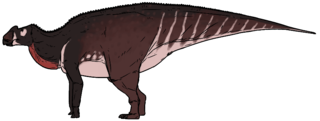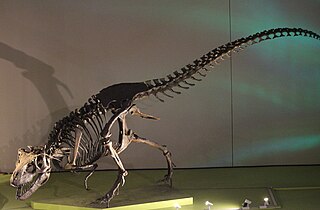
Neovenator is a genus of carcharodontosaurian theropod dinosaur. It is known from several skeletons found in the Early Cretaceous (Hauterivian-Barremian) Wessex Formation on the south coast of the Isle of Wight, southern England. It is one of the best known theropod dinosaurs from the Early Cretaceous of Europe.

Aralosaurus was a genus of hadrosaurid dinosaur that lived during the Late Cretaceous in what is now Kazakhstan. It is known only by a posterior half of a skull and some post-cranial bones found in the Bostobe Formation in rocks dated from the Upper Santonian-Lower Campanian boundary, at about 83.6 Ma. Only one species is known, Aralosaurus tuberiferus, described by Anatoly Konstantinovich Rozhdestvensky in 1968. The genus name means Aral Sea lizard, because it was found to the northeast of the Aral Sea. The specific epithet tuberiferus means bearing a tuber because the posterior part of the nasal bone rises sharply in front of the orbits like an outgrowth. Aralosaurus was originally reconstituted with a nasal arch similar to that of North American Kritosaurus. For many years, Aralosaurus was thus placed in the clade of the Hadrosaurinae. This classification was invalidated in 2004, following the re-examination of the skull of the animal which allowed to identify in Aralosaurus many typical characters of Lambeosaurinae. In particular, this study revealed that Aralosaurus had a hollow bony structure located far in front of the orbits, which communicated with the respiratory tract. This structure being broken at its base, its shape and size remains undetermined. More recently, Aralosaurus has been identified as the most basal Lambeosaurinae, and placed with its close relative Canardia from the upper Maastrichtian of France in the new clade of Aralosaurini.
Jeffrey A. Wilson, also known as JAW, is a paleontologist and professor of geological sciences and assistant curator at the Museum of Paleontology at the University of Michigan.

Siamosaurus is a genus of spinosaurid dinosaur that lived in what is now known as China and Thailand during the Early Cretaceous period and is the first reported spinosaurid from Asia. It is confidently known only from tooth fossils; the first were found in the Sao Khua Formation, with more teeth later recovered from the younger Khok Kruat Formation. The only species Siamosaurus suteethorni, whose name honours Thai palaeontologist Varavudh Suteethorn, was formally described in 1986. In 2009, four teeth from China previously attributed to a pliosaur—under the species "Sinopliosaurus" fusuiensis—were identified as those of a spinosaurid, possibly Siamosaurus. It is yet to be determined if two partial spinosaurid skeletons from Thailand and an isolated tooth from Japan also belong to Siamosaurus.

Pectinodon is a genus of troodontid theropod dinosaurs from the end of the Maastrichtian age of the Late Cretaceous period (66 mya). It currently contains a single valid species, Pectinodon bakkeri, known only from teeth.

Ekrixinatosaurus is a genus of abelisaurid theropod which lived approximately 100 to 97 million years ago during the Late Cretaceous period. Its fossils have been found in Argentina. Only one species is currently recognized, Ekrixinatosaurus novasi, from which the specific name honors of Dr. Fernando Novas for his contributions to the study of abelisaurid theropods, while the genus name refers to the dynamiting of the holotype specimen. It was a large abelisaur, measuring between 6.5 and 8 m in length and weighing 800 kg (1,800 lb).

Nuthetes is the name given to a genus of coelurosaurian theropod dinosaur, either a dromaeosaurid or a tyrannosauroid, known only from fossil teeth and jaw fragments found in rocks of the middle Berriasian age in the Cherty Freshwater Member of the Lulworth Formation in England and also the Angeac-Charente bonebed in France. If it was a dromaeosaurid, Nuthetes would have been a small predator.

Kinnareemimus is an extinct genus of ornithomimosaurian theropod dinosaur that was discovered in the Early Cretaceous Sao Khua Formation in what is now Thailand. The genus contains only the type species, K. khonkaenensis. The specific epithet is after Khon Kaen Province, which is in northeastern Thailand, where the remains of the animal were discovered.

Ornithomimoides is a dubious genus of theropod dinosaur, from the Late Cretaceous Lameta Formation of India. Two species have been identified, the type species O. mobilis and O. barasimlensis, were named by von Huene in 1932 and were described by Matley in 1933 though they are known only from isolated vertebrae. O. barasimlensis is known from five dorsal vertebrae, and O. mobilis from four smaller vertebrae, found at the same location.
James Ian Kirkland is an American paleontologist and geologist. He has worked with dinosaur remains from the southwest United States of America and Mexico and has been responsible for discovering new and important genera. He named Animantarx, Cedarpelta, Eohadrosaurus, Jeyawati, Gastonia, Mymoorapelta, Nedcolbertia, Utahraptor, Zuniceratops, Europelta and Diabloceratops. At the same site where he found Gastonia and Utahraptor, Kirkland has also excavated fossils of the therizinosaur Falcarius.

Brohisaurus is a genus of titanosauriform sauropod dinosaur from the Late Jurassic (Kimmeridgian-aged) Sembar Formation of Pakistan. The type species is B. kirthari.
Paleontology or palaeontology is the study of prehistoric life forms on Earth through the examination of plant and animal fossils. This includes the study of body fossils, tracks (ichnites), burrows, cast-off parts, fossilised feces (coprolites), palynomorphs and chemical residues. Because humans have encountered fossils for millennia, paleontology has a long history both before and after becoming formalized as a science. This article records significant discoveries and events related to paleontology that occurred or were published in the year 2001.
The Pab Formation is a Late Cretaceous geologic formation in Balochistan, in western Pakistan. It is dominated by sandstone, with minor mudstone and shale components. Dinosaur remains are among the fossils that have been recovered from the formation.
The Nanxiong Formation is a Late Cretaceous geologic formation in Guangdong Province. Dinosaur remains are among the fossils that have been recovered from the formation.

Qiupalong is an extinct genus of ornithomimosaurian theropod that was discovered in the Late Cretaceous Qiupa Formation of Henan, China. The genus contains a single species, Q. henanensis, the specific epithet for which was named for the province of Henan. Uniquely, Qiupalong is one of the few Late Cretaceous non-avian dinosaurs known from both Asia and Laramidia. Specimens from Russia and Alberta have been referred to the genus without being assigned to the type species.

Oxalaia is a genus of spinosaurid dinosaur that lived in what is now the Northeast Region of Brazil during the Cenomanian stage of the Late Cretaceous period, sometime between 100.5 and 93.9 million years ago. Its only known fossils were found in 1999 on Cajual Island in the rocks of the Alcântara Formation, which is known for its abundance of fragmentary, isolated fossil specimens. The remains of Oxalaia were described in 2011 by Brazilian palaeontologist Alexander Kellner and colleagues, who assigned the specimens to a new genus containing one species, Oxalaia quilombensis. The species name refers to the Brazilian quilombo settlements. Oxalaia quilombensis is the eighth officially named theropod species from Brazil and the largest carnivorous dinosaur discovered there. One study suggested that this taxon is a junior synonym of the closely related African genus Spinosaurus, but this was disputed by subsequent studies which consider the genus to be diagnostic.

Nanuqsaurus is a genus of tyrannosaurine theropod dinosaur known from the Late Cretaceous period Prince Creek Formation of the North Slope of Alaska, having lived roughly 70-68 million years ago. It contains a single species, Nanuqsaurus hoglundi, known only from a partial skull and multiple undescribed postcranial and teeth elements.
The Ilek Formation is a Lower Cretaceous geologic formation in Western Siberia. Many different fossils have been recovered from the formation. It overlies the Late Jurassic Tyazhin Formation and underlies the Albian Kiya Formation.

Phuwiangvenator is an extinct genus of megaraptoran theropod that lived during the Early Cretaceous period in what is now Thailand. It contains only the type species, P. yaemniyomi. The generic name of Phuwiangvenator comes from the Phu Wiang mountains, where the holotype was discovered, and the Latin word "venator" meaning hunter. The specific name, "yaemniyomi", is in honor of Sudham Yaemniyom, who was a historical paleontologist from Thailand and the first person to discover fossils there.














